![]()
![]()
![]()
Use LEFT and RIGHT arrow keys to navigate between flashcards;
Use UP and DOWN arrow keys to flip the card;
H to show hint;
A reads text to speech;
25 Cards in this Set
- Front
- Back
- 3rd side (hint)
|
What are hormones (and the endocrine glands) |
Hormones: chemicals released directly into blood. Carried in the blood to parts of the body, but only affect particular cells in target organs. Produced in various glands, called endocrine glands: -Pituitary gland produces many hormones that regulate body conditions. Is the ‘master gland’. -Thyroid gland produces thyroxine, which is involved in regulating things like the rate of metabolism, heart rate and temperature. -Adrenal glands-Produce adrenaline for fight or flight response. -Ovaries (female) produce oestrogen for menstrual cycle. -Pancreas- produce insulin for regulating the blood glucose level. -Testes (male) produce testosterone for controlling puberty and sperm production. |
|
|
|
Difference between hormones and neurones |
Neurones: -very fast -act for a very short time -act on a precise area Hormones: -slower action -act for a long time -act in a more general way |
|
|
|
How does adrenaline work? |
Is the hormone released by the adrenal glands and prepares body for fight or flight by activating processes that increases the supply of oxygen and glucose to cells How it works: -adrenaline binds to specifics receptors in the heart, which causes the heart muscle to contract more frequently and with more force, so heart rate and blood pressure increases. -This increases boood flow to the muscles so the cells receive more oxygen for increased respiration.-Adrenaline also binds to receptors in the liver. This causes live to break down it glycogen stores to release glucose. -This increases the blood glucose level, so there’s more glucose in the blood to be transported to the cells. |
|
|
|
Negative feedback |
When your body detects that the levels of substance has gone above of below the normal level, it triggers a response to bring it back to the normal level. |
|
|
|
What is thyroxine and what does it do? |
Thyroxine is released by the thyroid gland. Regulates metabolic rate- the speed at which chemical reactions occur. A negative feedback system keeps the amount of thyroxine in the blood at the right level: -when the blood thyroxine level is lower than normal, the hypothalamus is stimulated to release thyrotropin realising hormone (TRH). -TRH stimulates the pituitary gland to release thyroid stimulating hormone (TSH). -TSH stimulates the thyroid gland to release thyroxine, so blood thyroxine levels rises back to normal. -When blood thyroxine level becomes higher than normal, the release of TRH from the hypothalamus is inhibited, which reduces the production of TSH, so blood thyroxine level falls. |
|
|
|
Stages of the menstrual cycle. |
1) menstruation starts (day 1). Lining of uterus breaks down and is released. 2) uterus lung is repaired (day 4 -14). This happens until it becomes a thick and spongy layer of blood vessels ready for a fertilised egg to implant. 3) egg develops and is released (day 14) from the ovary (ovulation). 4) the lining is maintained (for 14 days until day 28). If no fertilised egg has landed on the uterus wall by day 28, the spongy lining starts to break down again and the whole cycle starts over. |
|
|
|
The menstrual cucle |
FSH is released from pituitary gland. Causes follicle to mature. Maturing follicle produces oestrogen (causes uterus lining to thicken). And, pituitary gland to produce LH. Ovulation. Follicle becomes corpus luteum. Corpus luteum produces progesterone (which maintains uterus lining. And, high levels of progesterone inhibits FSH release. Corpus luteum and progesterone decreases. FSH inhibitation is lifted. |
|
|
|
Roles of the 4 hormones in the menstrual cycle. |
1) FSH (follicle-stimulating hormone). Released by the pituitary gland. Causes a follicle (an egg and it’s surrounding cells) to mature in one of the ovaries. Stimulates production. 2) oestrogen. Released by the ovaries. Causes the lining of the uterus to thicken and grow. A high level stimulates an LH surge. 3) LH ( luteinising hormone). Released by pituitary gland. The LH stimulates ovulation at day 14- the follicle ruptured and the egg is released. Stimulates the remains of the follicle to develop into a structure called corpus luteum- which secretes progesterone. 4) progesterone. Released by the corpus luteum after ovulation. Maintains the lining of the uterus. Inhibits the release of FSH and LH. When the level of progesterone falls, and there’s a low oestrogen level, the uterus lining breaks down. A low progesterone level allows FdH to increase and be whole cycle starts again. |
|
|
|
2 uses of hormones to treat infertility |
Clomifene therapy. Some women are infertiles as dont ovulate or not regularly. Can take drug called clomifene. Works by causing more FDH and LH to be released in body, which stimulate agh maturation and ovulation. By knowing when ovulating, couple can have intercourse during this period to increase chance of becoming pregnant. IVF (in vitro fertilisation) IVF involves collecting eggs from ovaries and fertilising in lad with sperm. These then grow into embryos, once tiny balls of cells, one or two of them are transferred to women’s uterus to improve chance of pregnancy. FSH and LH are given before egg collection to stimulate egg production. This is an example of Assisted Reproductive Technology (ART)- a fertility treatment that involves eggs being handled outside of body. |
|
|
|
Types of contraceptives |
Hormones can be used as contraceptives. Eg oestrogen can be used to prevent the release of a egg. Progesterone can also be used to reduce fertility. Works in several ways, one of which is by stimulating the production of thick cervical mucus, which prevents sperm getting through the entrance to uterus and reaching egg. Some contain both oestrogen and progesterone, which as the combing pull (oral contraceptive) and the contraceptive patch (worn in skin). Mini pull and contraceptive injection both contain progesterone only. Pregnancy can also be prevented by barrier methods. |
|
|
|
Pros and cons of hormonal and barrier contraceptive methods. |
Hormonal are not effective then barrier. Hormonal also means couple doesn’t have to stop and think. However hormonal methods and unpleasant side-effects, such as headaches, acne and mood changes. Hormonal also doesn’t protect against sexual transmitted infections. |
|
|
|
What is homeostasis? |
-conditions in body need to be kept steady as otherwise cells can’t function properly. -examples of homeostasis includes: 1) osmoregulation (water). 2) thermoregulation (body temperature). 3) blood glucose regulation. -negative feedback systems keep conditions in body steady |
|
|
|
How does insulin and glycogen control blood glucose concentration |
1) eating foods containing carbohydrate puts glucose into blood from small intestines. 2) the normal metabolism of cells removed glucose from the blood. 3) vigorous exercise removes much more glucose from blood. 4) excess glucose can be stored as glycogen in the liver and in the mucus. 5) when these stores are full then the excess glucose is stored as lipid (fat) in the tissues. Using the hormone insulin and glucagon and show : |
|
|
|
Causes and treatments of type 1 diabetes |
-A condition where the pancreas produces little or no insulin. The result is a persons blood glucose can rise to a level that can kill them. -treated by insulin therapy, usually involves injecting insulin into subcutaneous fat where it will enter the bloodstream. Often done at mealtimes to make sure glucose is removed from the blood quickly once the food has been digested. This stops level of glucose in blood from getting too high. Very effective treatment. Amount depends on persons diet and how active they are. As well as insulin therapy, they have to think about -limiting the intake of food rich in simple carbohydrates -taking regular exercise. |
|
|
|
What are the causes and treatments for type 2 diabetes? |
-A condition where pancreas doesn’t produce enough insulin or when person becomes resistant to insulin. -there is a correlation between obesity and type 2 diabetes. People are obese if they have a bmi of above 30, or have a hip-to-wait ratio of 1.0 for men or 0.85 for women. -controlled by healthy eating, regular exercise and losing weight. Some people also have medication or insulin injections. |
|
|
|
What is thermoregulation and how is it controlled? |
-Body temp has to be regulated so enzymes don’t denature. -controlled by hypothalamus (in the brain). It contains receptors that are sensitive to blood temperatures. Also received impulses from receptors in the skin that provide info on external temps WHEN TOO HOT: -erector muscles relax so hairs lie flat. -Lots of sweat is produced in sweat glands in the dermis. The sweat is released onto surface of skin through pores. When sweat evaporated it transfers energy from skin to environment which cools you down. -Blood vessels close to the surface for the skin dilate, called vasodilation. It allows more blood to flow near the surface, so it can transfer more energy into surroundings. WHEN TOO COLD -erector muscles contract so hair stand on end. This traps air which acts as an insulator. - very little sweat produced. -Blood vessels near surface of skin construct (vasoconstriction). Means less blood flows near surface, so less energy transferred to the surroundings. -When cold you shiver, This increases rate of respiration, which transfers more energy to warm the body. |
|
|
|
Osmoregulation in the kidneys |
-regulating water content is important as it keeps cells functioning normally. If water conc is too high, water moves by osmosis which can cause cells to burst. If water conc is too low, water lives out of cells into blood by osmosis, and causes cells too shrink. Kidneys help to regulate water content by controlling how much water is réabsorbes and how much is lots in urine. |
|
|
|
3 main roles of kidneys |
1) to remove urea from blood. Urea is produced in the liver from the break down of excess amino acids. 2) adjustment of ion levels in the blood. 3) adjustment of water content of the blood. Does this by filtering stuff out of blood under high pressure, than reabsorbing useful stuff. End product is urine. |
|
|
|
What are nephrons? |
Nephrons are the filtration units in the kidneys |
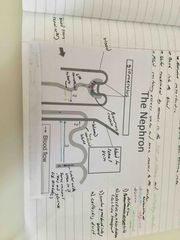
1) the liquid prt of the blood (containing water, urea, ions and glucose) is forced out of the glomerulus and into the bow and capsule at high pressure (ultrafiltration). Bigger molecules (eg proteins) and blood cells can’t pass through the membrane so are not forced out. 2) as liquid flows along the nephron, useful substances are reabsorbed: -all the glucose is selectively reabsorbed, it’s moved back into the blood against the concentration gradient. -Sufficient ions are reabsorbed. -Sufficient water is reabsorbed, according to the level of the hormone ADH. 3 water is t absorbed (eg urea, excess water, excess ions) continues out of the nephron via the collecting duct. It then passes into the ureter and down the bladder as urine. Urine is released through the urethra. |
|
|
How is water content controlled by a negative feedback system? |
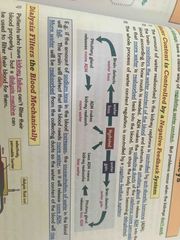
The amount of water reabsorbed in the kidney nephrons is controllled by anti-diuretic hormone (ADH). The brain monitors water content of blood and instructs the pituitary gland to release ADH into the blood according to how much needed. ADH makes the collecting ducts of the nephrons more permeable so that more water is reabsorbed back into blood. Stops body from becoming dehydrated. |
|
|
|
How is water content controlled by a negative feedback system? |
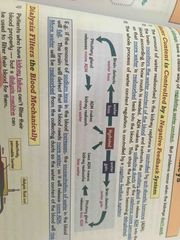
The amount of water reabsorbed in the kidney nephrons is controllled by anti-diuretic hormone (ADH). The brain monitors water content of blood and instructs the pituitary gland to release ADH into the blood according to how much needed. ADH makes the collecting ducts of the nephrons more permeable so that more water is reabsorbed back into blood. Stops body from becoming dehydrated. |
|
|
|
How do dialysis filters filter the blood. |
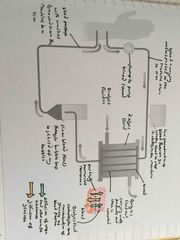
Patients who have kidney failures need a dialysis machine to filter their blood for them. Dialysis has to be done regularly to keep dissolved substances at the right concentrations, and to remove waste. Dialysis fluid had the same conc of salts and glucose as blood plasma (which means those aren’t removed from the blood). The barrier is permeable to things like ions and waste substances, but not big molecules like proteins (like membranes in the kidney). So the waste substances plus excess ions and water from the blood, more across the membrane into the dialysis fluid. Cells and proteins stay in the blood. |
|
|
|
How is water content controlled by a negative feedback system? |
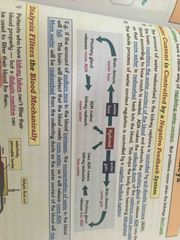
The amount of water reabsorbed in the kidney nephrons is controllled by anti-diuretic hormone (ADH). The brain monitors water content of blood and instructs the pituitary gland to release ADH into the blood according to how much needed. ADH makes the collecting ducts of the nephrons more permeable so that more water is reabsorbed back into blood. Stops body from becoming dehydrated. |
|
|
|
How do dialysis filters filter the blood. |
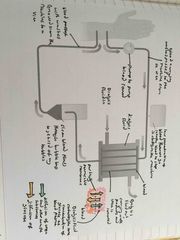
Patients who have kidney failures need a dialysis machine to filter their blood for them. Dialysis has to be done regularly to keep dissolved substances at the right concentrations, and to remove waste. Dialysis fluid had the same conc of salts and glucose as blood plasma (which means those aren’t removed from the blood). The barrier is permeable to things like ions and waste substances, but not big molecules like proteins (like membranes in the kidney). So the waste substances plus excess ions and water from the blood, more across the membrane into the dialysis fluid. Cells and proteins stay in the blood. |
|
|
|
Kidney transplants |
Currently, on cure for kidney disease is a kidney transplant. Kidneys are usually transplanted from people who die suddenly and are on the organ donor register. Donor kidney can be rejected by patients immune system, so to prevent this, precautions are taken: 1) a donor with a tissue type that closely matched the patient is chosen. 2) the patient is treated with drugs that suppress the immune system, so that they immune system won’t attack the transplanted kidney. |
|

